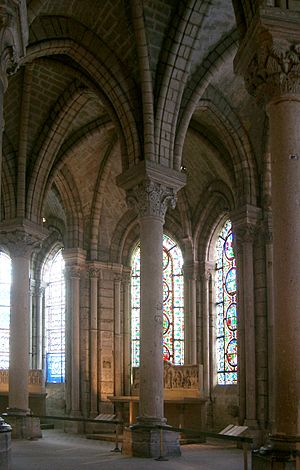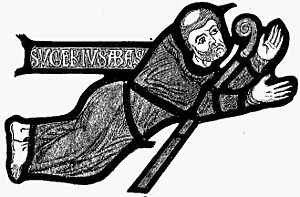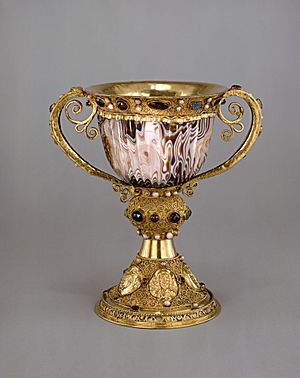Suger facts for kids
Suger (Latin: Sugerius) was an important French abbot, statesman, and historian. He lived from about 1081 to 1151. Suger was one of the first people to support Gothic architecture. He is often given credit for making this building style popular.
Contents
Suger's Early Life and Education
Suger's family background is not fully known. He sometimes wrote that he came from a simple family. In 1091, when he was ten years old, Suger was sent to the Abbey of St. Denis. This is where he began his education.
He trained at a smaller monastery called Saint-Denis de l'Estrée. There, he first met the person who would become King Louis VI of France. From 1104 to 1106, Suger went to another school. In 1106, he became a secretary to the abbot of Saint-Denis. An abbot is the head of a monastery.
Suger's Rise to Power
In the next few years, Suger became a provost in different towns. A provost was like a manager of church lands. In 1118, King Louis VI sent Suger to meet Pope Gelasius II. He also lived for a time at the court of the next Pope, Calixtus II.
When he returned, Suger became the abbot of St-Denis. For several years, he worked on important matters for the kingdom. Then, he spent about ten years making big changes and improvements at St-Denis.
In 1137, Suger went with the future king, Louis VII, to Aquitaine. This was for the king's marriage to Eleanor of Aquitaine. During the Second Crusade (1147–1149), Suger helped rule the kingdom. He was against the king's divorce later on. Even though he did not like the Second Crusade, he was planning a new one when he died.
Suger was a close friend and advisor to both King Louis VI and King Louis VII. He encouraged the kings to stop powerful nobles who acted like bandits. He also helped the kings deal with town movements and improve how justice was managed.
Suger's Impact on Art and Architecture
Suger made his abbey, which owned a lot of land, much richer and more beautiful. He did this by building a new church in the new Gothic style.

Abbot Suger decided around 1137 to rebuild the large Church of Saint-Denis. This church was the burial place for French kings.
Rebuilding the West Front
Suger started by rebuilding the front of the church, called the West front. He designed it to look like the Roman Arch of Constantine. It had three parts and three large doors. These doors helped people enter and exit more easily. The round window above the main West door, called a rose window, is one of the earliest known examples.
Designing the East End
After finishing the West front in 1140, Abbot Suger began rebuilding the eastern part of the church. He wanted the choir (the area where the clergy sat) to be full of light. To do this, his builders used several new ideas. These included the pointed arch, ribbed vaults, and an ambulatory (a walkway) with chapels around it. They also used flying buttresses. These supports allowed for very large windows, called clerestory windows, high up in the walls.
The new church was finished and officially opened on June 11, 1144. The king was there for the event. The Abbey of Saint-Denis became a model for other churches built in northern France. It is often called the very first building in the Gothic style. About a hundred years later, the older part of Saint-Denis was also rebuilt in the Gothic style.
Suger as an Art Patron
Suger also supported other forms of art. He ordered many beautiful items for church services. These included a golden eagle, a special vase called the Queen Eleanor vase, and a gold chalice.
Suger's Writings
Suger became a leading historian of his time. He wrote a book praising King Louis VI, called Vita Ludovici regis. He also helped write a history of King Louis VII, which might have been more balanced.
In his books Liber de rebus in administratione sua gestis and Libellus de consecratione ecclesiae S. Dionysii, he wrote about the improvements he made to St Denis. He described the church's valuable treasures. He also explained how the church was rebuilt. Suger's writings encouraged the monks of St Denis to write history. This led to many official historical records being written.
See also
In Spanish: Suger para niños



